Um ator
interpretando mais de um personagem na mesma peça é algo comum no teatro. Também
é comum no cinema, desde a era muda. Obviamente, com o tempo tudo pôde ficar
mais interessante, e em vez de apenas dois papéis, um ator podia interpretar
três – como Peter Sellers em “Doutor Fantástico”, de 1964 – ou mais papéis.
Minha pesquisa descobriu que o ator que interpretou a maior quantidade de
papéis em um só filme foi Michael Palin em “Monty Python em Busca do Cálice Sagrado”
(1975) – ele interpretou DOZE personagens (embora possamos dizer que Buster
Keaton interpretando todos na cena do concerto em “The Play House”, de 1921,
perfaça mais que 12 personagens). Alec Guinness não ficou com o recorde no
livro do Guinness (hahaha), mas ele fez proeza semelhante à de Palin 26 anos
antes.
An actor
playing more than one role in the same play is something common in theater. It
is also common in film, since the silent era. Of course, with time things could
become more interesting, and instead of the standard two roles, one actor could
play three – like Peter Sellers in “Doctor Strangelove”, from 1964 – or more
roles. My research found that the actor that played the most roles in a single
film was Michael Palin in “Monty Python and the Holy Grail” (1975) - he played
TWELVE characters (although it can be said that Buster Keaton playing everyone
in the music hall scene from 1921's “The Play House” outnumbers 12). Alec
Guinness didn't get the Guinness Book record (see what I did?), but he preceded
Palin's prowess by 26 years.
Na cadeia,
na noite anterior à sua execução, Louis (Dennis Price) conta sua história.
Começa o flashback. Louis é filho de um cantor italiano e de uma nobre inglesa
que fugiu para se casar. O pai de Louis morreu quando ele nasceu, e a família
da mãe a rejeitou. Ela criou Louis com dificuldade, mas sempre o lembrando de
que ele era um duque. Também rejeitado pela família D’Ascoyne, Louis começa a
trabalhar numa loja de tecidos e sofre quando sua mãe morre e também quando a
moça de quem ele gosta, Sibella (Joan Greenwood), o rejeita.
In the jail,
the night before being executed, Louis (Dennis Price) tells his story. Enters
the flashback. Louis is the son of an Italian singer and an English noblewoman
who eloped and left her family. His father died when he was born, and his
mother's family wouldn't accept her back. She raised Louis with difficulty, but
she always reminded him that he was a Duke by birth. Also rejected by the
D'Ascoyne family, Louis goes to work as a draper and suffers when his mother
dies and also when the girl he loves, Sibella (Joan Greenwood), rejects him.
É aí que
ele se lembra de algo que Mamãe disse uma vez: se 12 pessoas da família D’Ascoyne
morressem, ele seria o herdeiro. Então Louis começa a ler o obituário
diariamente na esperança de que essas pessoas tenham morrido – até que ele
decide terminar o trabalho sozinho e matar os últimos oito membros da família D’Ascoyne
– todos interpretados por Alec Guinness.
Then he
remembers something Mama once said: if some 12 people from the D'Ascoyne family
dropped dead, he would be the heir. So Louis starts reading the obituary daily
in the hope to see those people dead – until he decides to finish the job
himself and kill the last eight D'Ascoynes – all played by Alec Guinness.
O primeiro
encontro e a primeira morte são fruto do acaso, e dali em diante Louis começa a
planejar sua vingança. Seus planos mudam um pouco quando ele se interessa por
Edith (Valeria Hobson), viúva de uma das vítimas. É ela que diz a frase que dá
o título original do filme em inglês.
The first
meeting and killing is by chance, and from then on Louis starts plotting his
revenge. His plans change a bit, of course, when he becomes interested in Edith
(Valerie Hobson), the widow of one of his victims. She is the one to quote the
original film title.
“As Oito
Vítimas” prova o que nós já sabemos: que Alec Guinness é um ator muito, muito
bom. E não é que ele se parece um pouco com Lon Chaney quando está
caracterizado como o fotógrafo de 24 anos – que parece ter bem mais do que 24
anos? Também é divertido ver Guinness interpretando uma mulher, Agatha D’Ascoyne,
uma sufragista em uma sequência breve e sem falas.
“Kind Hearts
and Coronets” proves what we already know: that Alec Guinness is a very, very
good actor. And doesn't he look a bit like Lon Chaney when he plays the
24-year-old photographer – who looks WAY older than 24? It's also fun to see
Guinness as a woman, Agatha D'Ascoyne, a suffragette in a very brief sequence
without lines.
Logo antes
de fazer este filme, Alec Guinness interpretou Fagin em “Oliver Twist” (1948),
um papel que também exigiu transformação física com maquiagem e perucas.
Obviamente, isso foi muito pouco se comparado com as oito caracterizações de “As
Oito Vítimas”. Originalmente, Guinness ia interpretar apenas três membros da
família D’Ascoyne, mas ele insistiu em interpretar todos os oito – desafiando
pessoas da indústria do cinema que não acreditavam que Alec poderia ser uma
grande estrela de cinema.
Right before
making this film, Alec Guinness played Fagin in “Oliver Twist” (1948), a role
for which he also underwent physical transformation with make-up and wigs. Of
course, this was very little next to the eight characterizations in “Kind
Hearts and Coronets”. Originally, Guinness was going to play three members of
the D’Ascoyne family, but he insisted on playing all eight – thus defying the
people in the film industry who though Alec couldn’t become a big film star…
Quando
Louis se oferece para se casar com Edith, depois de respeitado o período de
luto, temos uma interessante composição de cena: entre Edith e Louis,
conversando, há a cadeira do falecido marido, nunca mais usada após a morte
dele – é a presença invisível atravancando os planos de Louis. Mas um diálogo
posterior revela que Louis na verdade ama Sibella, com quem ele ainda se
encontra, mesmo ela sendo casada.
When Louis
offers himself to marry Edith, after the grief period is over, we have an
interesting disposal of the props: between Edith and Louis, as they talk, there
is the late husband's chair, never used again after his passing – it’s the
invisible presence working against Louis’s plans. But a later dialogue reveals
that Louis really loves Sibella, who he's still seeing, even though she is
married.
O filme
foi produzido por Michael Balcon – fundador dos estúdios Balcon-Saville-Fredman
e Gainsborough Pictures, estúdios onde Hitchcock trabalhou na era muda, e
também avô de Daniel Day-Lewis – e dirigido por Robert Hamer. Hamer também
adaptou o livro para a tela, e ficou muito animado por poder fazer um filme
diferente de todos que já haviam sido feitos na Inglaterra. Balcon mais tarde
disse que “As Oito Vítimas” era seu filme favorito feito nos estúdios Ealing, e
aquele que resistiria ao teste do tempo – como de fato aconteceu.
The film was
produced by Michael Balcon – founder of the Balcon-Saville-Freedman studios and
Gainsborough Pictures, where Hitchcock worked in the silent era, and also
Daniel Day-Lewis's grandfather – and directed by Robert Hamer. Hamer also adapted
the novel to the screen, and was more than excited to be able to make a film
unlike any other ever made in England. Balcon later said that “Kind Hearts and
Coronets” was his favorite film made at Ealing studios, and the one that would
certainly stand the test of time – as it did.
“As Oito
Vítimas” se passa durante a era Eduardiana, o que significa que você verá
muitos figurinos maravilhosos – eu até prefiro a moda da Era Eduardiana à da Era
Vitoriana, simplesmente porque eu imagino que os vestidos da década de 1910 são
mais confortáveis. Sibella e Edith usam lindos vestidos – mesmo sendo de
classes sociais diferentes, não vejo muita diferença no figurino das duas,
talvez apenas nos acessórios.
“Kind Hearts
and Coronets” is set during the Edwardian era, which means that you'll see many
wonderful outfits – I actually prefer the Edwardian fashion to the Victorian
fashion, simply because I imagine the 1910’s dresses to be more comfortable. Sibella
and Edith both wear beautiful dresses - even though they are from different
classes, I don’t see much difference between their outfits, maybe only between
their accessories.
SPOILERS!
Sagaz,
charmoso e surpreendente – porque Louis NÃO foi condenado à morte por causa dos
assassinatos! – “As Oito Vítimas” sofreu com a idiotice do Código Hays. Como o
Código exigia que todos os crimes fossem punidos – algo MUITO LONGE da
realidade – uma cena teve de ser adicionada ao final de “As Oito Vítimas”
quando o filme estreou nos EUA, tirando o brilhantismo de seu roteiro.
Felizmente, o cinema se livrou desta bobagem e hoje nós podemos, e devemos,
apreciar “As Oito Vítimas” em toda sua glória britânica original e
Witty,
charming and surprising – because Louis was NOT condemned to be killed because
of the murders! – “Kind Hearts and Coronets” suffered with the Production Code’s
idiocy. Because the Code demanded all crimes in film to be punished – something
FAR AWAY from the truth – a scene had to be added to the ending of “Kind Hearts
and Coronets” when it was released in the US – destroying the brilliant
screenplay. Thankfully, cinema got rid of this nonsense and now we can, and
must, appreciate “Kind Hearts and Coronets” in all its original unapologetic British
glory.
P.S.: Depois de escrever o post, fiquei sabendo de algumas façanhas ainda maiores alcançadas no cinema mudo: em 1916, o ator Marcel Perez interpretou DEZESSEIS personagens no curta-metragem "A Busy Night", que ele mesmo dirigiu, e em 1929 Lupino Lane interpretou VINTE E QUATRO personagens e dirigiu "Only Me"!
P.S.: After writing this post, I got to know about even bigger prowesses accomplished in silent cinema: in 1916, actor Marcel Perez played SIXTEEN character in the short film "A Busy Night", directed by himself, and in 1929 Lupino Lane played TWENTY-FOUR characters and directed the aptly titled "Only Me"!
This is my
contribution to the Rule Britannia Film Blogathon, hosted by Terence at A
Shroud of Thoughts.
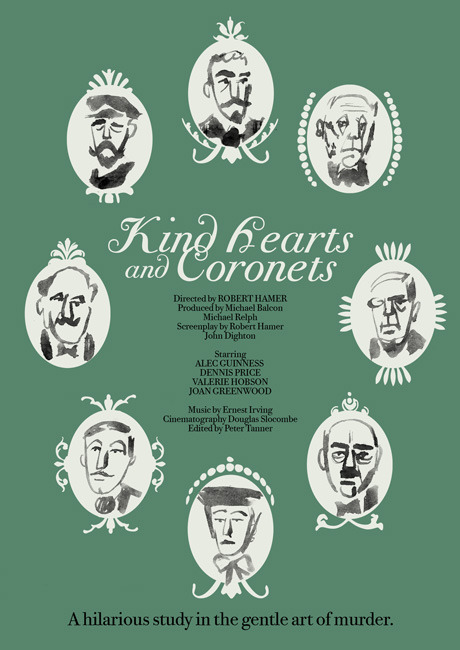

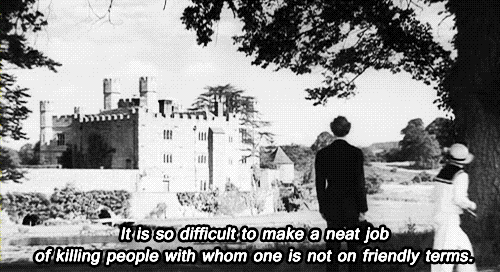
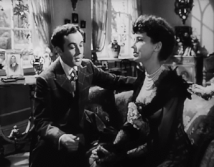


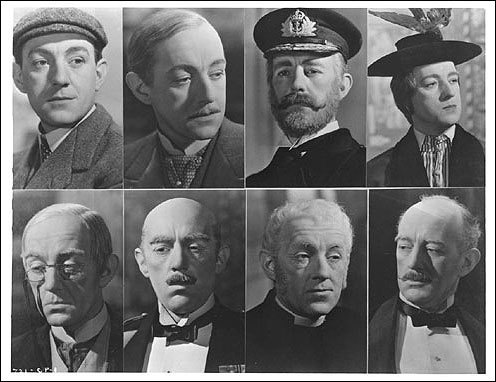

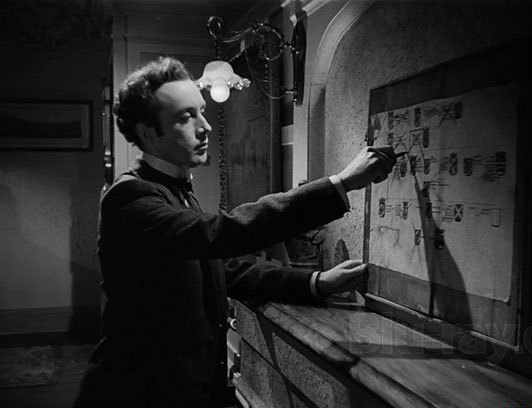


4 comments:
You wrote an excellent article on this classic British comedy that is indeed timeless. The combination of wit and flat-out slapstick is infectious and never grows old.
Still looking for this one. I remember someone else reviewing it for another blogathon and I started looking round, but it hasn't been at the used video store and my library hasn't got it yet. Good review and I'll keep looking.
Thank you so much for taking part in the blogathon! Kind Hearts and Coronets is one of my favourite Ealing comedies and even after having seen it multiple times I am still amazed at Sir Alec Guinness's multiple performances. He was simply amazing. Definitely one of the greatest comedies ever made.
I'm going to sound silly when I say that I haven't seen this film. I have definitely heard a lot a lot about it, but somehow it has seemed to escape me. Fantastic post Le, and thanks for giving me a new film to watch.
I also invite you to check out my late contribution to the blogathon.
https://crystalkalyana.wordpress.com/2018/08/12/the-elephant-man-1980/
Post a Comment